Automated Visual Evaluation and geospatial Mapping (AVE-Map) for cervical cancer screening optimization in sub-Saharan Africa
Project Summary
Cervical cancer is a major public health problem in sub-Saharan Africa (SSA). The World Health Organization (WHO) launched the 90-79-90 campaign aimed at eliminating cervical cancer by vaccinating 90% of the eligible population, screening 70% of women and treating 90% of women in need by 2030. However, despite the effectiveness of available screening technologies such as cytology, visual inspection with acetic acid (VIA) and high risk Human Papillomavirus [hrHPV] testing, only 10-20% of eligible women in SSA are currently screened, largely due to barriers of technical expertise, laboratory capacity, cost, and access. Cytology and HPV DNA testing are associated with technical demands and significant cost, while VIA, though less expensive, has been found to have limited sensitivity and high inter-observer variability, and practitioners often lose confidence in the technique without support.
Use of mobile phone based technology has been successfully utilized by experts to support providers performing VIA, but this requires significant engagement of experts to perform a subjective test. Low-cost, easy to use, and scalable techniques for screening, as well as innovative implementation strategies are therefore needed to meet targets for the next decade.
Innovators such as Mobile ODT, a biotechnology company based in Israel, which has developed EVA COLPO— a portable, Internet-connected, and FDA-cleared colposcope that is as simple to use as a smartphone have developed various approaches to capture cervical images on smart phones for enhanced diagnostic accuracy. EVA integrates captured images with AI-based software algorithms to facilitate diagnosis, as well as link this data with electronic health records.
While fully developed and available commercially, such technology has not previously been implemented in resource-limited settings. Geospatial data science has great potential to improve clinical care delivery. Geospatial data science utilizes unique theory and analytic techniques to incorporate geographic data into various aspects of data science. One key aspect of high relevance to clinical care delivery is to determine where disease prevalence is highest and thus where resource utilization should be optimally allocated. While most public health systems have good documentation of where care can be delivered (e.g., in existing clinics and hospitals), the alignment with patient need is often absent and care is usually delivered in an opportunistic fashion. This mismatch results in wasted resources in some settings and unmet need in others.
The project aims to optimize AVE for cervical cancer screening in sub Saharan Africa by building a repository of cervical images, developing an AVE algorithm and piloting the AVE algorithm at different health systems. Using geospatial mapping, the project will also determine access and scale up of cervical cancer screening. We will preliminarily evaluate this strategy using the REAIM implementation framework.

